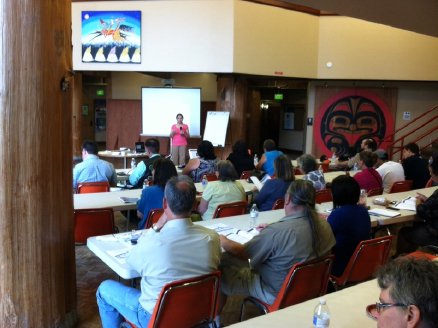by Lyn Hunter, Philanthropy Northwest
Duwamish. Salish. Lakota. Tlingit. Haida. Umatilla. Nez Perce. These were a few of the ways that over 100 people identified themselves on June 26th at Daybreak Star. We gathered to discuss the findings of a broad-based community engagement process of the local urban Indian community in King County. Its purpose? To document the assets, opportunities, hopes and aspirations of the community and identify a shared vision for the future. The near term goal? Translating their vision into action. Our introductions alone were a powerful illustration of the diversity of the American Indian/Native American peoples who reside in urban communities. The gathering and its companion report, was guided by an advisory committee made up of local urban Indian community leaders and supported by the United Way of King County in cooperation with other local funders including The Seattle Foundation, the City of Seattle and the Muckleshoot Indian Tribe.
 The vision statement prompted much self-reflection by the group: “Was this us? What about this?” “We need to include this.” The conversation got a little sticky but a participant respectfully brought the conversation back around to the task at hand: “It’s upon us to weave those words into our future. It’s up to every person here to move this forward and see beyond today.” And I couldn’t help but reflect on the value and importance of the dynamic human-ness of our work. As Peter Pennekamp wrote “formulas will never replace honest, open and constructive engagement by those who are implicated in the decision.” Or in this case, hopefully the beginning of some decisions.
The vision statement prompted much self-reflection by the group: “Was this us? What about this?” “We need to include this.” The conversation got a little sticky but a participant respectfully brought the conversation back around to the task at hand: “It’s upon us to weave those words into our future. It’s up to every person here to move this forward and see beyond today.” And I couldn’t help but reflect on the value and importance of the dynamic human-ness of our work. As Peter Pennekamp wrote “formulas will never replace honest, open and constructive engagement by those who are implicated in the decision.” Or in this case, hopefully the beginning of some decisions.
We convened into four groups based upon the four pillars of the Community Vision: 1) Investing in youth, 2) Nurturing community empowerment and involvement, 3) Increasing visibility and presence and 4) Providing a roadmap for funders and supporters. In the latter group, the “funders” group, these were some of the specific things they wanted to share with you, the funding community:
- The need to disaggregate data
- Differences between urban and rural native populations
- Eligibility differences (i.e., enrolled, non-enrolled, disenrolled, etc.)
- Ongoing mental health issues like becoming trauma-aware, the latent effects of de-colonization and lateral violence (in marginalized groups where members strike out at each other as a result of being oppressed. The oppressed become the oppressors of themselves and each other),
- How to continue to build a strong sense of community and momentum building
- Assessing which grants are realistic and attainable
- Influencing public policy
- Financial education particularly about access to credit especially for youth
A recent comment by Sen. Jon Tester at a recent Senate Indian Affairs Committe hearing underscores the need for developing a deeper understanding of funding opportunities for Indian Country. Tester, the Committee chair, said that not a single one of the 68 Indian CDFIs received funding from the Community Development Financial Institutions Fund in its latest funding round in 2013.
The Seattle-King County urban Indian community is vibrant and alive and filled with committed individuals who are deeply connected to this place we all call home. Next on the agenda is a funders’ briefing that will likely be during the second week of August. We are in the midst of planning the content so please let me know if any of these particular topics strike a chord with you. I hope to see you there.


